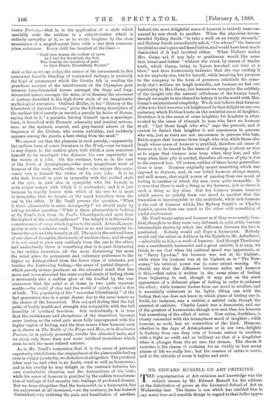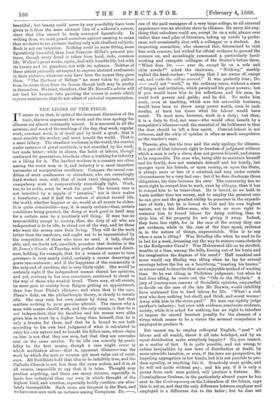MR. EDWARD RUSSELL ON ART CRITICISM.
'11HE popularisation of Art criticism and knowledge was the subject chosen by Mr. Edward Russell for his address at the distribution of prizes at the Liverpool School of Art on Wednesday last. The theme is one which has enabled him to say many true and sensible things in regard to that fuller appre- ciation of Art by the public which is so much the need of the English people. It is characteristic of the English as a race, to be always eager to add to their stock of intellectual and moral enjoyments. The Latin races have no such hunger for intel- lectual enjoyment in the abstract. They either like or do not like. Things which they do not like naturally, they have no marked desire to acquire a liking for. The Teutonic races, with whom the imagination is always the predominant quality, for ever feel the desire to find fresh food on which to feed the soul of man. This desire is present throughout the whole of Mr. Russell's address. He wishes, and he evidently desires, that his readers shall wish to obtain from Art " a greater quantity and better quality of moral nutriment." He is not content to take from the figurative arts those enjoyments of sense which are primarily theirs to bestow. He wants, and rightly thinks that the English people generally want, to get beyond this to something that will stimulate not merely the sense of form, colour, harmony, or proportion, but which will awaken the imagina- tion. That is, he wants to see the general public taught to admire pictures and sculpture in such a way as to get out of them something beyond mere sensuous enjoyment.
Doubtless this is a commendable demand ; but still, we by no means feel sure that he is not asking too much, that he is not requiring for the world at large that which, in truth, is given to very few. Primarily, what pleases in a piece of sculpture or a picture is form, or colour, or both. The figurative arts appeal to us by these means, and so must be considered for the greater part as the arts of the senses. No man can like Titian's "Bacchus and Ariadne " who is not affected by form and colour. The picture appeals to him by these means. Had it another name and another story, none of the charm would be lost. Though we did not know that it is Bacchus who leaps from the car, the figure of the young man in its perfect grace and harmony of outline, and "the light-blue hills" of the distance, would affect none the less deeply those who are born with the love of form and colour. Of course, those endowed with a special aptitude may, and do go beyond the mere enjoyment of the senses. Those in whom this appreciation is naturally refined and intense, by care and study are able to endow themselves with a power akin to instinct which goes beyond the first blind sensations of delight, and enables them to feel the passion with which the artist worked, and to sympathise with his intention. We have no doubt that this power of appre- ciation is higher and better worth attaining, than that which comes of what we must call again the blind sensations of delight awakened by beauty of form or colour. That English people, who, after all, are more keenly endowed with the intellectual longing for moral enjoyment than any other race in the world, should wish for this power, is also natural enough. Still, we cannot help feeling that those who, with Mr. Russell, think it possible to interest people primarily in pictures by teaching them this, the highest form of in- tellectual pleasure to be derived from Art, are making a mistake. A man must first appreciate the figurative arts as matters of sensation. If he can do this, there is no reason why he should not rise to higher things. If he cannot, it is little use to attempt to approach him from the intellectual side. Mr. Russell tells a story of three factory operatives who were staring "blankly, almost sleepily," at Briton Riviere's "Return of Ulysses," and saw nothing in it until a bystander had told them the story of Argus ' recognising his old master. The story known, the men looked with pleasure on what had before been mere weariness to them. No doubt so delightful a story would be certain to charm them. What delighted them, however, was not the picture, but the story. Had the picture been a really great one, and had the factory operatives been (as perhaps they were, for the instance is not good as a test case) possessed of the sense of form and colour, they would have liked the picture long before they knew the story. It must not be imagined that we fancy that such a feeling for form is not to be found in England except among people of so- called cultivation. We believe it to be quite as likely or unlikely to be found among the poor as among the rich. The present writer remembers hearing of an English maid in Paris who wandered into the Louvre, and came back to her mistress to say that she had seen something which she was sure was the most beautiful thing in the whole world. Her explanation very soon showed that she had come unawares on the "Venus of Milo. She was by nature possessed of the power of appre- ciating beauty of form. To have told her of all the lore of Greek art and Greek mythology, of how the sculptors worked, and by what symbolism they denoted the manifestations of divinity, would doubtless have enlarged and widened her enjoy- ment. Had she, however, been unpossessed of the sense of beauty in form, to have told her all this would have been utterly useless. It could not have given her the sense she did not possess.
We trust that in writing thus we shall not be taken to dissent from the main thesis of Mr. Russell's address, which is that "we want as full a share as we may have of the content which comes not merely of admiring, but of knowing why we should admire." Perhaps it would be more accurate to say that what we want to be taught, is to admire not half-heartedly, but with a whole heart, to get the greatest possible amount of delight out of a picture or a statue. Without instruction, this is doubt- less impossible. Still, this statement represents generally the need of the public in regard to instruction in Art. We may quote here what Mr. Russell says as to the outside help which a picture may receive from knowledge as to its subject and treat- ment :—" Considerations of theme, of the poetry and literature of a subject, of the imagination which it has engendered in tie most memorable minds, of the events with which it is entwined, of the best meaning in the picture and all the links that bind that meaning to sympathies which are not for an age but for all time,—these must always heighten the dignity, inform the beauty, enhance the interest, flavour the sweetness, expand and illuminate the tragedy, stamp deeper the impression of any great work. And a swifter and easier sense of all such associations is one of the things for which we simple outside art-lovers crave." Of many paintings and pieces of sculpture, especially those which are portraits, this is no doubt perfectly true. For instance, that fine example of Grano-Roman sculpture, Germanicus Casting the Bean, gains immensely in interest when we know the striking symbolism with which it is connected. Still, we must never forget that works of art must always be able to stand alone, must be able to impress by themselves, and without the aid of knowledge from outside. Such help may increase our interest and delight immensely. If it creates it altogether, we may be sure that such interest and delight come from the story, from the knowledge, not from the work of art.
To what Mr. Russell says when, in the latter part of his address, he turns from the popularisation of criticism, and advises the students as to the choice of subjects for pictures, we can only give a qualified assent. He advises them to choose subjects in the works of the novelists, in Tolstoi, Daudet, Hardy, Baring-Gould, George Meredith, Stevenson, Rhoda Broughton. So far as following such advice would practically mean that the artist should always choose modern subjects for his pic- tures, we heartily support it. We hold nothing more strongly in Art than that the artist should deal with the modern world in which be lives, and in which it is his business to find the beautiful and the heroic, not with a bygone age, which, however treated, can give us nothing more human than galvanised mummies in the place of men. For the artist to call his pictures by names taken from modern novels, will ensure us pictures of the life of to-day. We must not, however, hide from ourselves the fact that there is a danger in the artist seeking scenes in novels. He is very apt to attempt to illustrate scenes and incidents which in the novel are pathetic or beautiful enough, but which cannot possibly be treated pictorially. Modern artists are so much inclined already to choose sub- jects which are radically unfit for pictures, that to urge them to take that course seems very unadvisable. It is essential that an artist should understand clearly the limitations of his art. How often do we see painters take subjects which, though eminently beautiful and fitting when treated in prose or poetry, are ridiculous and impossible for pictures. Charles Lamb has pointed out how poverty, which can be treated with perfect pathos and dignity in poetry, becomes contemptible when represented on the stage by a man dressed in a seedy suit of black. So, in a poem, the pathos of the widowed cobbler left working alone in his little shop, with his motherless children round him, may be rendered with perfect dignity. In a picture, such as we were asked to admire some few years ago in the Academy, where the pathos cannot be shown except figuratively, the squalid and amiable-looking middle-aged man whom, but for the catalogue, we could never have guessed to be suffering any particular grief of heart, awakened no feeling but disgust at misapplied skill. The subject was one utterly unfit for a picture. Had the cobbler and his shop been beautiful in themselves, the picture would have been beautiful ; but beauty could never by any possibility have been given to it from the mere abstract idea of a widower's sorrow, since that idea cannot be truly conveyed figuratively. In writing thus, we must guard ourselves against seeming to mean that we desire to see pictures dealing only with idealised subjects. Such is not our intention. Nothing could be more fitting, more figuratively beautiful, than Jean Francois Millet's peasant pic- tures, though every detail is taken from hard, rude, common life. Walker's great works, again, deal with humble life, but with its beauty and its grandeur, not with its ugliness. Neither of these artists primarily attempted to express abstract sentiments in their pictures, whatever may have been the names they gave them. "The Harbour of Refuge" no more takes its pathos from its name than from its frame, though both may be pretty in themselves. We trust, therefore, that Mr. Russell's advice will not lead his hearers into painting the scenes in novels which express sentiments that do not admit of pictorial representation.




































 Previous page
Previous page